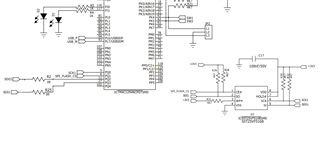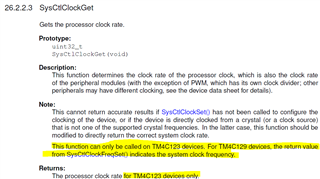Hello,
I'm trying to use SPI communication between TM4C1294NCPDT and SST25VF016B. Slave device MISO (SDI1)(SPI Flash SST25VF016B )is not responding .
Please refer the enclosed code , circuit and help to resolve the issue.
Thank you.
.
#include <stdbool.h>
#include <stdint.h>
#include "inc/hw_memmap.h"
#include "inc/hw_ints.h"
#include "driverlib/debug.h"
#include "driverlib/gpio.h"
#include "driverlib/interrupt.h"
#include "driverlib/pin_map.h"
#include "driverlib/rom.h"
#include "driverlib/rom_map.h"
#include "driverlib/ssi.h"
#include "driverlib/sysctl.h"
#include "driverlib/uart.h"
#include "utils/uartstdio.h"
#include "inc/hw_ssi.h"
#include "inc/hw_types.h"
//*****************************************************************************
//
//! \addtogroup example_list
//! <h1>SSI Master-to-Slave Transfer (spi_master_slave_xfer)</h1>
//!
//! This example demonstrates how to configure SSI0 as a SSI Master and SSI1
//! as a SSI slave. The master will send four characters on the master to the
//! slave using the legacy mode. In legacy mode, one bit is sent on each
//! SSI Clock pulse. Once the SSI slave receives the four characters in the
//! receive FIFO it will generate an interrupt.
//!
//! This example uses the following peripherals and I/O signals. You must
//! review these and change as needed for your own board:
//! - SSI0 peripheral
//! - GPIO Port A peripheral (for SSI0 pins)
//! - SSI0Clk - PA2
//! - SSI0Fss - PA3
//! - SSI0TX - PA4
//! - SSI0RX - PA5
//!
//! - SSI1 peripheral
//! - GPIO Port B & E peripheral (for SSI1 pins)
//! - SSI1Clk - PB5
//! - SSI1Fss - PB4
//! - SSI1TX - PE4
//! - SSI1RX - PE5
//!
//! This example requires board level connection between SSI0 and SSI1.
//!
//! UART0, connected to the Virtual Serial Port and running at 115,200, 8-N-1,
//! is used to display messages from this application.
//
//*****************************************************************************
//****************************************************************************
//
// The variable g_ui32SysClock contains the system clock frequency in Hz.
//
//****************************************************************************
#define SCK1 GPIO_PIN_0
#define CS GPIO_PIN_1
#define SDO0 GPIO_PIN_2
#define SDI0 GPIO_PIN_3
uint32_t g_ui32SysClock;
static uint8_t SPI1_Initialized = 0;
//==============================================================================
// Pin Configurations
//==============================================================================
// Initialize chip select as Output
//#define INIT_CS() ((MAP_SysCtlPeripheralEnable(SYSCTL_PERIPH_GPIOQ))\
// (MAP_SysCtlPeripheralEnable(SYSCTL_PERIPH_SSI3))\
// (MAP_GPIOPinTypeGPIOOutput(GPIO_PORTQ_BASE, GPIO_PIN_1)))
#define SDSPICSAssert() (MAP_GPIOPinWrite(GPIO_PORTQ_BASE, GPIO_PIN_1,0)) //(LATBCLR = (unsigned int)(BIT_15))
#define SDSPICSDeAssert() (MAP_GPIOPinWrite(GPIO_PORTQ_BASE, GPIO_PIN_1,2)) //(LATBSET = (unsigned int)(BIT_15))
#define SST25_WRITE_BYTE(X) (SPI1_WriteByte((X)))
#define SST25_READ_BYTE() (SPI1_ReadByte())
#define SST25_WRITE_BYTE(X) (MAP_SSIDataPut(SSI3_BASE,X))
#define SST25_READ_BYTE(X) (X=MAP_SSIDataGetNonBlocking(SSI3_BASE,X))//SPI1_ReadByte()
void SPI_Flash_ResetWriteProtection(void);
uint8_t SPI_Flash_WriteBusy(void);
void SPI1_Init_HighSpeed(void);
void SPI1_DeInit(void);
uint32_t glbdatarx[20]={0};
extern void SPIFlashInit(uint32_t ui32Base, uint32_t ui32Clock, uint32_t ui32BitRate);
/************************************************************************
* SST25 Commands
************************************************************************/
#define SST25_CMD_WRSR (unsigned)0x01 // Write Status Register
#define SST25_CMD_WRITE (unsigned)0x02
#define SST25_CMD_READ (unsigned)0x03
#define SST25_CMD_RDSR (unsigned)0x05 // Read Status Register
#define SST25_CMD_WREN (unsigned)0x06
#define SST25_CMD_EWSR (unsigned)0x50
#define SST25_CMD_ERASE (unsigned)0x60
//*****************************************************************************
//
// Global flag to indicate data has been received.
//
//*****************************************************************************
volatile uint32_t g_breceiveFlag = 0;
//*****************************************************************************
//
// Number of bytes to send and receive.
//
//*****************************************************************************
#define NUM_SSI_DATA 4
//////////////////////
void SPI_Flash_Init(void)
{
// uint32_t ui32_TReset;
//
// ui32_TReset=MAP_SysCtlClockGet()*3*.0000002; // 200 ns delay
// INIT_CS();
MAP_SysCtlPeripheralEnable(SYSCTL_PERIPH_GPIOQ);
MAP_SysCtlPeripheralEnable(SYSCTL_PERIPH_SSI3);
MAP_GPIOPinTypeGPIOOutput(GPIO_PORTQ_BASE, GPIO_PIN_1);
// SDSPICSAssert();
// MAP_SysCtlDelay(ui32_TReset); // hold L
// SDSPICSDeAssert();
SPI1_Init_HighSpeed();
SPI_Flash_ResetWriteProtection();
}
/////////////////////////
void SPI1_Init_HighSpeed(void)
{
if(SPI1_Initialized)
SPI1_DeInit();
{
MAP_GPIOPinConfigure(GPIO_PQ0_SSI3CLK);
MAP_GPIOPinConfigure(GPIO_PQ1_SSI3FSS);
MAP_GPIOPinConfigure(GPIO_PQ2_SSI3XDAT0); //tx
MAP_GPIOPinConfigure(GPIO_PQ3_SSI3XDAT1); //rx
MAP_SSIConfigSetExpClk( SSI3_BASE, MAP_SysCtlClockGet(), SSI_FRF_MOTO_MODE_0,
SSI_MODE_MASTER,
(100000),
8);
SSIAdvModeSet(SSI3_BASE, SSI_ADV_MODE_READ_WRITE);//SSI_ADV_MODE_QUAD_WRITE);//SSI_ADV_MODE_READ_WRITE);//SSI_ADV_MODE_QUAD_WRITE);
// MAP_SSIAdvFrameHoldEnable(SSI3_BASE);
MAP_GPIOPinTypeSSI(GPIO_PORTQ_BASE, GPIO_PIN_0 |GPIO_PIN_2 | GPIO_PIN_3 );
MAP_SysCtlPeripheralEnable(SYSCTL_PERIPH_SSI3);
MAP_SSIEnable(SSI3_BASE);
SPI1_Initialized = 1;
}
}
//////////
void SPI1_DeInit(void)
{
MAP_SSIDisable(SSI3_BASE);//SpiChnClose(SPI_CHANNEL1);
SPI1_Initialized = 0;
}
/////////////////////
void SPI_Flash_ResetWriteProtection(void)
{
uint32_t ui32_TReset;
ui32_TReset=MAP_SysCtlClockGet()*3*.0000002; // 200 ns delay
SDSPICSAssert();
// MAP_SSIDataPut(SSI3_BASE, (SST25_CMD_EWSR));
MAP_SSIDataPutNonBlocking(SSI3_BASE, (SST25_CMD_EWSR));
SDSPICSDeAssert();
// Delay for next I/O
MAP_SysCtlDelay(ui32_TReset); // hold L
// MAP_SSIDataPut(SSI3_BASE, (0));
MAP_SSIDataPutNonBlocking(SSI3_BASE, (0));
SDSPICSAssert();
//MAP_SSIDataPut(SSI3_BASE, (SST25_CMD_WRSR));
//MAP_SSIDataPut(SSI3_BASE, (0));
MAP_SSIDataPutNonBlocking(SSI3_BASE, (SST25_CMD_WRSR));
MAP_SSIDataPutNonBlocking(SSI3_BASE, (0));
SDSPICSDeAssert();
// while (MAP_SSIBusy(SSI3_BASE));
while(SPI_Flash_WriteBusy());
}
//////////////////////
/************************************************************************
* Function: void SST25ReadArray(DWORD address, uint8_t* pData, nCount)
*
* Overview: this function reads data into buffer specified
*
* Input: flash memory address, pointer to the data buffer, data number
*
************************************************************************/
void SPI_Flash_RawRead(uint32_t address, uint32_t *pData, uint32_t nCount)
{
uint32_t temp=0xff,itr;
union
{
uint32_t addr;
char addrbyt[4];
}un;
un.addr=0;
un.addr=address;
SPI1_Init_HighSpeed();
SDSPICSAssert();
// while((HWREG(SSI3_BASE + SSI_O_SR) & SSI_SR_RNE) )
{
MAP_SSIDataPut(SSI3_BASE, SST25_CMD_READ);
MAP_SSIDataPut(SSI3_BASE, un.addrbyt[2]);
MAP_SSIDataPut(SSI3_BASE, un.addrbyt[1]);
MAP_SSIDataPut(SSI3_BASE, un.addrbyt[0]);
//MAP_SSIDataGet(SSI3_BASE, &temp); //dummy write
//MAP_SSIDataPutNonBlocking(SSI3_BASE, SST25_CMD_READ);
//MAP_SSIDataPutNonBlocking(SSI3_BASE, un.addrbyt[2]);
//MAP_SSIDataPutNonBlocking(SSI3_BASE, un.addrbyt[1]);
//MAP_SSIDataPutNonBlocking(SSI3_BASE, un.addrbyt[0]);
//MAP_SSIDataGet(SSI3_BASE, &temp); //dummy write
//SSIAdvModeSet(SSI3_BASE, SSI_ADV_MODE_QUAD_READ);//SSI_ADV_MODE_QUAD_WRITE);
while(nCount--)
{
*pData++= MAP_SSIDataGetNonBlocking(SSI3_BASE,pData);//SST25_READ_BYTE();
}
SDSPICSDeAssert();
}
// SDSPICSDeAssert();
}
/************************************************************************
* Function: SST25WriteEnable()
*
* Overview: this function allows write/erase SST25. Must be called
* before every write/erase command.
*
* Input: none
*
* Output: none
*
************************************************************************/
void SPI_Flash_WriteEnable(void)
{
SDSPICSAssert();
// MAP_SSIDataPut(SSI3_BASE, SST25_CMD_WREN);
MAP_SSIDataPutNonBlocking(SSI3_BASE, SST25_CMD_WREN);
SDSPICSDeAssert();
}
/////////////
/************************************************************************
* Function: uint8_t SST25IsWriteBusy(void)
*
* Overview: this function reads status register and chek BUSY bit for write operation
*
* Input: none
*
* Output: non zero if busy
*
************************************************************************/
uint8_t SPI_Flash_WriteBusy(void)
{
uint32_t Status;
SDSPICSAssert();
//MAP_SSIDataPut(SSI3_BASE, SST25_CMD_RDSR);
//MAP_SSIDataGet(SSI3_BASE, &Status);
MAP_SSIDataPutNonBlocking(SSI3_BASE, SST25_CMD_RDSR);
Status = MAP_SSIDataGetNonBlocking(SSI3_BASE, &Status);
SDSPICSDeAssert();
return (Status & 0x01);
}
////////////////////////
void SPI_Flash_RawErase(void)
{
SPI1_Init_HighSpeed();
SPI_Flash_WriteEnable();
SDSPICSAssert();
// MAP_SSIDataPut(SSI3_BASE, SST25_CMD_ERASE);
MAP_SSIDataPutNonBlocking(SSI3_BASE, SST25_CMD_ERASE);
SDSPICSDeAssert();
// Wait for write end
while(SPI_Flash_WriteBusy());
}
//////////
/************************************************************************
* Function: void SST25WriteByte(BYTE data, DWORD address)
*
* Overview: this function writes a byte to the address specified
*
* Input: data to be written and address
*
* Output: none
*
************************************************************************/
void SPI_Flash_WriteByte(uint8_t data, uint32_t address)
{
uint8_t temp=0xff;
union
{
uint32_t addr;
uint8_t addrbyt[4];
}un;
address=25;
un.addr=address;
SPI_Flash_WriteEnable();
SDSPICSAssert();
// MAP_SSIDataPut(SSI3_BASE, temp); //dummy write
MAP_SSIDataPut(SSI3_BASE, SST25_CMD_WRITE);
MAP_SSIDataPut(SSI3_BASE, un.addrbyt[2]);
MAP_SSIDataPut(SSI3_BASE, un.addrbyt[1]);
MAP_SSIDataPut(SSI3_BASE, un.addrbyt[0]);
// data = SPI1_ReadByte();
// SST25_WRITE_BYTE(data); ///SPI1_WriteByte(data);
MAP_SSIDataPut(SSI3_BASE,data);
// MAP_SSIDataPutNonBlocking(SSI3_BASE, SST25_CMD_WRITE);
// MAP_SSIDataPutNonBlocking(SSI3_BASE, un.addrbyt[2]);
// MAP_SSIDataPutNonBlocking(SSI3_BASE, un.addrbyt[1]);
// MAP_SSIDataPutNonBlocking(SSI3_BASE, un.addrbyt[0]);
// temp = SPI1_ReadByte();
// SPI1_WriteByte(data);
// HWREG(SSI3_BASE + SSI_O_DR) = SST25_CMD_WRITE;
// HWREG(SSI3_BASE + SSI_O_DR) = un.addrbyt[0];
// HWREG(SSI3_BASE + SSI_O_DR) = un.addrbyt[1];
// HWREG(SSI3_BASE + SSI_O_DR) = un.addrbyt[2];
// temp=HWREG(SSI3_BASE + SSI_O_DR);
// HWREG(SSI3_BASE + SSI_O_DR) = data;
SDSPICSDeAssert();
while(SPI_Flash_WriteBusy());
}
///////////////////////////
void SPI1_WriteByte(uint8_t Byte)
{
uint32_t Data[2]={0};
if(SPI1_Initialized)
{
//SpiChnPutC( SPI_CHANNEL1, (Byte))
//MAP_SSIDataPut(SSI3_BASE,Byte);
MAP_SSIDataPutNonBlocking(SSI3_BASE, (Byte));
while((HWREG(SSI3_BASE + SSI_O_SR) & SSI_SR_RFF));// SSI_SR_RNE))
MAP_SSIDataGetNonBlocking(SSI3_BASE, Data);
//MAP_SSIDataGet(SSI3_BASE, Data);
// while((HWREG(SSI3_BASE + SSI_O_DR) & SSI_SR_TNF))// && (1 & SSI_TXFF))
//{
// while((HWREG(SSI3_BASE + SSI_O_SR) & SSI_SR_TFE))
//{
//HWREG(SSI3_BASE + SSI_O_DR) =Byte;
//while (MAP_SSIBusy(SSI3_BASE)); /// finish operation
//Wait for byte to be sent
//while(SPI1_RxBufferEmpty);
//Discard Junk read
//SpiChnGetC( SPI_CHANNEL1 );
//MAP_SSIDataPut(SSI3_BASE,Data);
//break;
//}
}
}
//////////
/************************************************************************
* Function: BYTE SST25WriteArray(DWORD address, BYTE* pData, nCount)
*
* Overview: this function writes a data array at the address specified
*
* Input: flash memory address, pointer to the data array, data number
*
* Output: return 1 if the operation was successfull
*
************************************************************************/
void SPI_Flash_RawWrite(uint32_t address, uint32_t *pData, uint32_t nCount)
{
uint32_t addr;
uint8_t *pD;
uint32_t counter;
addr = address;
pD = pData;
// while((HWREG(SSI3_BASE + SSI_O_SR) & SSI_SR_TNF))
{
SPI1_Init_HighSpeed();
// SDSPICSAssert();
// WRITE
for(counter = 0; counter < nCount; counter++)
{
SPI_Flash_WriteByte(*pD++, addr++);
}
// SDSPICSDeAssert();
}
}
/////////////
void PowerUpDelay(void)
{
long int pwt=0;
//INIT_CS();
//SDSPICSAssert();
for(pwt=0;pwt<500000;pwt++) //~50ms delay (500000)
{
;
}
//SDSPICSDeAssert();
}
//////////////////
uint8_t SPI1_ReadByte(void)
{
uint32_t data=0;
if(SPI1_Initialized)
{
// Write dummy to clock in data
// SpiChnPutC( SPI_CHANNEL1, (Dummy));
//MAP_SSIDataPut(SSI3_BASE, 0xFF);
MAP_SSIDataPutNonBlocking(SSI3_BASE, 0xFF);
while((HWREG(SSI3_BASE + SSI_O_SR) & SSI_SR_RFF));// SSI_SR_RNE))
//while(SPI1_RxBufferEmpty);
// Return read byte
MAP_SSIDataGetNonBlocking (SSI3_BASE,&data);
// MAP_SSIDataGet(SSI3_BASE,&data);
return data;//SpiChnGetC( SPI_CHANNEL1 );
}
else
{
return 0;
}
}
7
int main(void)
{
uint32_t pui32DataTx[NUM_SSI_DATA];
uint32_t pui32DataTx1[NUM_SSI_DATA];
uint32_t pui32DataRx[NUM_SSI_DATA];
uint32_t ui32Index,ui32Reset1;
uint32_t dely=0;
PowerUpDelay();
g_ui32SysClock = MAP_SysCtlClockFreqSet((SYSCTL_XTAL_25MHZ |
SYSCTL_OSC_MAIN |
SYSCTL_USE_PLL |
SYSCTL_CFG_VCO_240), 120000000);
pui32DataTx[0]=5; pui32DataTx[1]=6;
SPI_Flash_Init();
while (1)
{
SPI_Flash_RawWrite(25,pui32DataTx,1);
}
}




